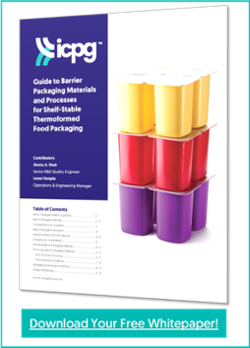 When it comes to the development of materials for shelf-stable and extended shelf-life food products, the use of barrier packaging material solutions achieved through performance materials and multi-layer coextruded barrier structures is required to keep the product safe and secure from the harmful effects of oxygen and moisture permeation that lead to food spoilage.
When it comes to the development of materials for shelf-stable and extended shelf-life food products, the use of barrier packaging material solutions achieved through performance materials and multi-layer coextruded barrier structures is required to keep the product safe and secure from the harmful effects of oxygen and moisture permeation that lead to food spoilage.
To better understand the role of barrier requirements, it helps to take a deeper look into the mechanisms used for testing these barrier packaging materials and how they contribute to the complete barrier packaging material solution. Two of the most important and widely used test method and standard used in food packaging industry used to establish barrier properties and thus shelf-life expectations this are the Oxygen Transmission Rate (OTR) and Moisture Vapor Transmission Rate (MVTR).
What is OTR?
Oxygen Transmission Rate (OTR) is the measurement of the amount of oxygen gas that passes through a substance over a given time period. OTR for plastic film material is the steady state rate at which the oxygen gas permeates through a film at specified conditions (temperature and relative humidity). OTR is measured for different food (solids and liquids) and medical packaging material solutions such as wood, cork, glass, aluminum, plastics (rigid and flexible), etc. In food packaging, permeation of oxygen through the packaging over time contributes to a process of food decay called oxidation, therefore, extending product shelf life through customized material barrier structures to reduce the rate at which oxygen permeation occurs is critical to maintaining the safety and quality of the food product.
What is MVTR?
Moisture (Water) Vapor Transmission Rate (MVTR/WVTR) is the measurement of amount of water vapor that permeates through the substance over a given time period. Similarly to OTR, MVTR is measured at specified condition such as temperature and relative humidity to either replicate the actual condition of use or run an accelerated testing for shelf life calculation.
How are OTR & MVTR measured?
There are various standard test methods to measure the OTR and MVTR of the material standardized by ASTM and ISO. The test method is selected based on the end application and the accuracy of the test results required for the packaged product:
-
- OTR Measurement:
Standard test methods are available for measuring the OTR of the packaging material be it in film, sheet, formed part such as tray, cup, bottle, etc. To conduct OTR testing, the barrier film or part is sealed between a chamber containing oxygen and a void of oxygen where a coulometric sensor measures the oxygen transmitted through the material at a selected temperature and humidity. The test is complete at the point of equilibrium, or steady state, when the sensor detects a constant amount of oxygen in the void oxygen chamber. The standard test conditions for OTR testing are 73°F (23°C) and 0% RH and the end result values are expressed in cc/100in2/24hr in US standard and cc/m2/24hr in metric unit. As an industry standard, a material or a package is considered to be a high oxygen barrier package when its OTR is less than 1 cc/100in2/24hr or 15.5 cc/m2/24hr.
- OTR Measurement:
Discover our XPP mono-material barrier solutions with enhanced oxygen & moisture barrier properties!
-
- MVTR Measurement:
Standard test methods are available for measuring the MVTR of the packaging material be it in film, sheet, or formed part such as tray, cup, bottle, etc. For MVTR testing, the barrier film or part is sealed between a chamber with high moisture content (wet chamber) and a dry chamber where a pressure modulated sensor then measures the moisture transmitted through the material at a selected temperature and humidity. The test is complete at the point of equilibrium, or steady state, when the infra-red sensor detects water molecules leaving the dry chamber at a constant rate. The standard test condition for MVTR testing are 100°F (37.8°C) and 90% RH and the end result values are expressed in g/100in2/24hr in US standard and g/m2/24hr in metric unit. Where there is no set standard value that decides if a material has high MVTR rate, industry considers Oriented Polypropylene (OPP) as the highest MVTR barrier material.
- MVTR Measurement:
What are the testing standards?
There are various ASTM and ISO test methods available for both OTR and MVTR. In North America, ASTM test methods are used a standard for testing any material for any specific material properties:
-
- OTR Standards: ASTM D3985 is the most widely used test method in plastics industry to accurately measure the oxygen gas transmission rate using a coulometric sensor method for plastics film and sheet.
- MVTR Standards: ASTM D1434 is the most widely used test method in plastics industry to accurately measure the moisture permeability using an IR sensor for plastics film and sheet.
- OTR Standards: ASTM D3985 is the most widely used test method in plastics industry to accurately measure the oxygen gas transmission rate using a coulometric sensor method for plastics film and sheet.
Some of the ASTM test methods to measure the OTR and MVTR include:
-
-
 F1307 Standard Test Method for Oxygen Transmission Rate Through Dry Packages Using a Coulometric Sensor
F1307 Standard Test Method for Oxygen Transmission Rate Through Dry Packages Using a Coulometric Sensor - F1927 Standard Test Method for Determination of Oxygen Gas Transmission Rate, Permeability and Permeance at Controlled Relative Humidity Through Barrier Materials Using a Coulometric Detector
- F2622 Standard Test Method for Oxygen Gas Transmission Rate Through Plastic Film and Sheeting Using Various Sensors
- ASTM E96 Standard Test Methods for Water Vapor Transmission of Materials
- ASTM E398 Standard Test Method for Water Vapor Transmission Rate of Sheet Materials Using Dynamic Relative Humidity Measurement
- ASTM F1249 Standard Test Method for Water Vapor Transmission Rate Through Plastic Film and Sheeting Using a Modulated Infrared Sensor
-
What effects the OTR and MVTR of material?
Generally, the OTR and MVTR is an inherent property of a material and where factor such as design play an important role, as a majority of functional barrier multi-layer packaging materials is achieved through a combination of materials with exceptional OTR and MVTR barrier to produce a serviceable package. Additional factors can effect the OTR & MVTR of a packaging material:
-
- Thickness:
Generally, the thicker the material, higher the OTR and MVTR rate, but there are process and cost limitation that restricts the thickness of the material in a package. For example, EVOH has exceptional OTR properties but it is an expensive material that is also brittle in nature. Thus, a very thin layer of EVOH is used in a multilayer coextrusion or extrusion laminated structure. EVOH is also hygroscopic in nature. Therefore, it is very important to dry the material before use and to have a material on each side of the EVOH, such as polypropylene, that acts as a moisture barrier to reduce the water uptake in the EVOH material that might affect the OTR functionality in the package. - Process:
The actual raw material production of EVOH presents a tradeoff between OTR barrier and processing, as the lower the ethylene mol%, the higher the barrier properties but the more difficult processing and vice versa. Apart from this, the orientation of the material also affects and lowers the MVTR rate as it aligns the molecular chains and creates a less torturous path for vapor molecules to pass through.
- Thickness:
In conclusion, the theory of permeation is complex, and the testing process can be time-consuming (with average test time is anywhere from 3 days to 3 weeks) and difficult to execute as any leak near the seal during the test results in a testing failure. Nevertheless, the testing of oxygen and water vapor permeability rates is a critical factor in the design, development and production of barrier extended shelf-life and shelf-stable food packaging applications as a means to maintaining the quality, safety and performance of the end-use product.
Interested in learning more about barrier packaging materials and processes for your extended shelf-life food packaging applications? Download our whitepaper:
- https://en.wikipedia.org/wiki/Oxygen_transmission_rate
- https://en.wikipedia.org/wiki/Moisture_vapor_transmission_rate#:~:text=Moisture%20vapor%20transmission%20rate%20(MVTR,where%20moisture%20control%20is%20critical.
- http://63.233.195.207/flexographic-otr.htm#:~:text=OTR%20(oxygen%20transmission%20rate)%20is,C)%20and%200%25%20RH.
- http://63.233.195.207/flexographic-wvtr.htm




